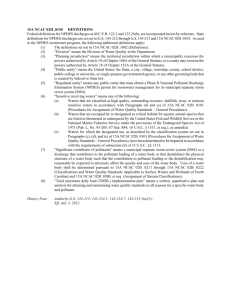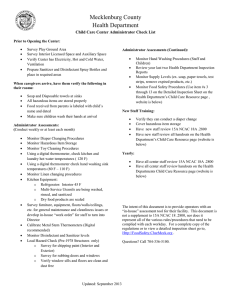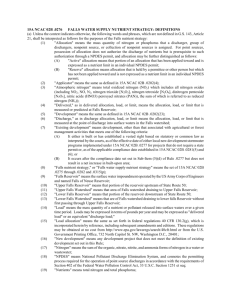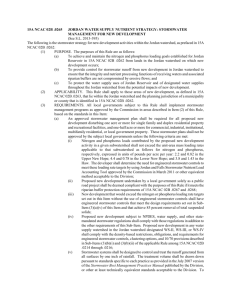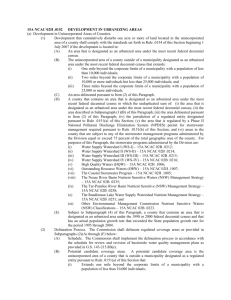CHECKLIST OF APPLICABLE STANDARDS :
advertisement
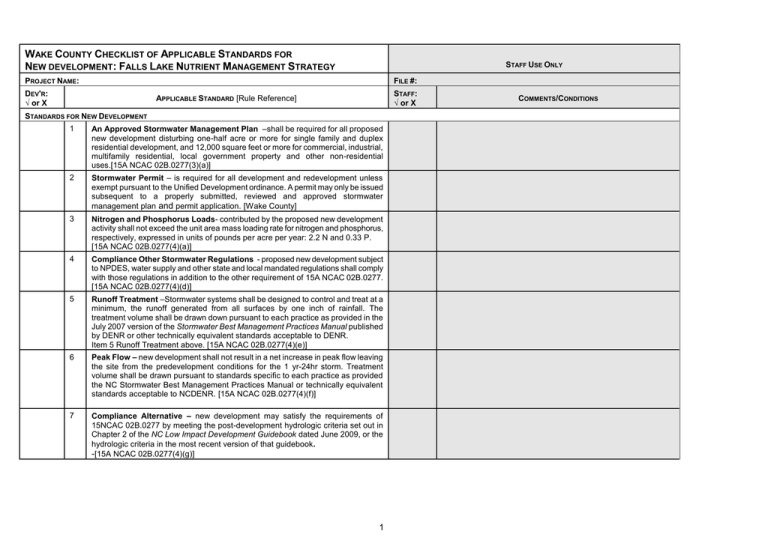
WAKE COUNTY CHECKLIST OF APPLICABLE STANDARDS FOR NEW DEVELOPMENT: FALLS LAKE NUTRIENT MANAGEMENT STRATEGY STAFF USE ONLY PROJECT NAME: FILE #: DEV'R: √ or X STAFF: √ or X APPLICABLE STANDARD [Rule Reference] STANDARDS FOR NEW DEVELOPMENT 1 An Approved Stormwater Management Plan –shall be required for all proposed new development disturbing one-half acre or more for single family and duplex residential development, and 12,000 square feet or more for commercial, industrial, multifamily residential, local government property and other non-residential uses.[15A NCAC 02B.0277(3)(a)] 2 Stormwater Permit – is required for all development and redevelopment unless exempt pursuant to the Unified Development ordinance. A permit may only be issued subsequent to a properly submitted, reviewed and approved stormwater management plan and permit application. [Wake County] 3 Nitrogen and Phosphorus Loads- contributed by the proposed new development activity shall not exceed the unit area mass loading rate for nitrogen and phosphorus, respectively, expressed in units of pounds per acre per year: 2.2 N and 0.33 P. [15A NCAC 02B.0277(4)(a)] 4 Compliance Other Stormwater Regulations - proposed new development subject to NPDES, water supply and other state and local mandated regulations shall comply with those regulations in addition to the other requirement of 15A NCAC 02B.0277. [15A NCAC 02B.0277(4)(d)] 5 Runoff Treatment –Stormwater systems shall be designed to control and treat at a minimum, the runoff generated from all surfaces by one inch of rainfall. The treatment volume shall be drawn down pursuant to each practice as provided in the July 2007 version of the Stormwater Best Management Practices Manual published by DENR or other technically equivalent standards acceptable to DENR. Item 5 Runoff Treatment above. [15A NCAC 02B.0277(4)(e)] 6 Peak Flow – new development shall not result in a net increase in peak flow leaving the site from the predevelopment conditions for the 1 yr-24hr storm. Treatment volume shall be drawn pursuant to standards specific to each practice as provided the NC Stormwater Best Management Practices Manual or technically equivalent standards acceptable to NCDENR. [15A NCAC 02B.0277(4)(f)] 7 Compliance Alternative – new development may satisfy the requirements of 15NCAC 02B.0277 by meeting the post-development hydrologic criteria set out in Chapter 2 of the NC Low Impact Development Guidebook dated June 2009, or the hydrologic criteria in the most recent version of that guidebook. -[15A NCAC 02B.0277(4)(g)] 1 COMMENTS/CONDITIONS 7 Replacement or Expansion w/No Net Increase in BUA – proposed development that would replace or expand structures or improvements that existed as of December 2006, the end of the baseline period, and that would not result in a net increase in built-upon area shall not be required to meet nutrient loading targets or high-density requirements except to the extent that the developer shall provide stormwater control at least equal to the previous development. [15A NCAC 02B.0277(4)(a)] 8 Replacement or Expansion with Net Increase in BUA proposed development that would replace or expand structures or improvements and that would result in a net increase in built-upon area shall have the option either to achieve at least the percentage loading reduction objectives stated in 15A NCAC 02B.0275 as applied to nitrogen (40%) and phosphorous (77%) loading from the previous development for the entire project site, or to meet the loading rate targets expressed in lbs/ac/yr of nitrogen 2.2 and phosphorous 0.33. [15A NCAC 02B.0277(4)(a)] 9 Riparian Buffers – new development shall comply with the riparian buffer protection requirements of 15A NCAC 02B.0233 and .0242 or subsequent amendments or replacements to those requirements. [15A NCAC 02B.0277(4)(h)] 10 Nutrient Offset Option- Developers shall have the option of offsetting part of their nitrogen and phosphorus loads by implementing or funding offset management measures. Before using the offsite offset option, a development shall implement onsite structural controls that achieve one of the following levels of reduction: (i) Proposed new development activity disturbing at least one-half acre but less than one acre of land for single family and duplex residential property and recreational facilities, except as stated in (iv) below, shall achieve 30 percent or more of the needed load reduction in both nitrogen and phosphorus loading onsite and shall meet any requirements for engineered stormwater controls described in Item 5 Runoff Treatment above; (ii) Proposed new development activity disturbing at least 12,000 but less than one acre of land for commercial, industrial, institutional, multifamily residential, or local government property and other non-residential property, except as stated in (iv) below, shall achieve 30 percent or more of the needed load reduction in both nitrogen and phosphorus loading onsite and shall meet any requirements for engineered stormwater controls described in Item 5 Runoff Treatment above; (iii) Except as stated in (iv) below, proposed new development activity that disturbs one acre of land or more shall achieve 50 percent or more of the needed load reduction in both nitrogen and phosphorus loading onsite and shall meet any requirements for engineered stormwater controls described in Item 5 Runoff Treatment above; or (iv) Proposed development that would replace or expand structures or improvements that existed as of December 2006 and that increases impervious surface within a local government's designated downtown area, regardless of area disturbed, shall achieve 30 percent of the needed load reduction in both nitrogen and phosphorus onsite, and shall meet any requirements for engineered stormwater controls described in Item 5 Runoff Treatment above. [15A NCAC 02B.0277(4)(b)(i-iv)] 2 11 Offsite Offsetting Measures – Developers shall meet onsite reduction requirements outlined in Item 10 Nitrogen Offset Option above before using the offsite offset option [15A NCAC 02B.0277(4)(b)]. Offsite offsetting measures shall achieve at least equivalent reductions in nitrogen and phosphorus loading to the remaining reduction needed onsite to comply with the loading target rates. A developer may use any measure that complies with 15A NCAC 02B.0240 and 15A NCAC 02B.0282. [15A NCAC 02B.0277(4)(c)] 12 Maintenance Plan – A plan to ensure maintenance, enforcement and compliance of Best Management Practices (BMPs) for the life of the new development. [15A NCAC 02B.0277(3)(b)–(c)] 8/10/2011 12:54:39 PM 3
